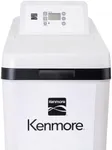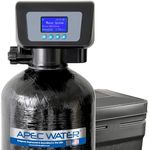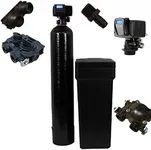Buying Guide for the Best Water Softeners
Choosing the right water softener can significantly improve the quality of your water, making it more pleasant for drinking, cooking, and cleaning. Water softeners work by removing minerals like calcium and magnesium that cause water hardness. When selecting a water softener, it's important to consider several key specifications to ensure you get the best fit for your household needs. Understanding these specifications will help you make an informed decision and enjoy the benefits of softened water.Grain CapacityGrain capacity refers to the amount of hardness the water softener can remove before it needs to regenerate. This is important because it determines how often the system will need to regenerate, which affects both water and salt usage. Grain capacities typically range from 20,000 to 80,000 grains. For small households with 1-2 people, a lower capacity (20,000-30,000 grains) may be sufficient. Medium-sized households (3-4 people) might need a capacity of 30,000-50,000 grains, while larger households (5+ people) should consider capacities of 50,000 grains or more. To pick the right one, consider the number of people in your household and your average water usage.
Regeneration TypeRegeneration type refers to how the water softener renews its ability to remove hardness. There are two main types: time-initiated and demand-initiated. Time-initiated systems regenerate at a set schedule, regardless of water usage, which can be less efficient. Demand-initiated systems regenerate based on actual water usage, making them more efficient and cost-effective. If your water usage varies, a demand-initiated system is likely the better choice. For consistent water usage, a time-initiated system may suffice.
Salt EfficiencySalt efficiency measures how effectively a water softener uses salt to regenerate. This is important for both environmental and cost reasons, as more efficient systems use less salt, reducing waste and saving money. Salt efficiency is often expressed in terms of grains of hardness removed per pound of salt. Higher efficiency systems will have higher grains per pound values. If you are concerned about salt usage and environmental impact, look for a high-efficiency model. For those less concerned, standard efficiency models may be adequate.
Water Flow RateWater flow rate indicates how much water the softener can process per minute, usually measured in gallons per minute (GPM). This is crucial for ensuring that your household has adequate water pressure, especially during peak usage times. Flow rates typically range from 7 to 20 GPM. Smaller households with fewer water fixtures can manage with lower flow rates (7-10 GPM), while larger households with multiple bathrooms and high water usage should consider higher flow rates (15-20 GPM). To choose the right flow rate, consider the size of your home and the number of water fixtures.
Control ValveThe control valve regulates the water softener's operation, including regeneration cycles. A reliable control valve is essential for the efficient functioning of the system. There are various types of control valves, including mechanical and digital. Mechanical valves are simpler and often more durable, while digital valves offer more precise control and additional features like programmable settings. If you prefer simplicity and durability, a mechanical valve may be best. For those who want more control and customization, a digital valve is the way to go.
Bypass ValveA bypass valve allows you to divert water around the softener, which is useful for maintenance or if you need to use untreated water for certain tasks. This feature is important for convenience and flexibility. Some systems come with a built-in bypass valve, while others require it to be purchased separately. If you anticipate needing to bypass the softener frequently, look for a model with an integrated bypass valve. For occasional use, a separate bypass valve may be sufficient.














![YARNA Capacitive Electronic Water Descaler Whole House Solution - Alternative No Salt Water Softener System, Reduces The Effects of Limescale and Hard Water [CWD48, Max 4" Pipe]](https://images-proxy.bestreviews.guide/6hlHdcDNxaZIWxtRWI9ZftZQcDA=/0x150/https://m.media-amazon.com/images/I/41tqqC5oGGL._AC_CX679_.jpg)
![YARNA Capacitive Electronic Water Descaler Whole House Solution - Alternative No Salt Water Softener System, Reduces The Effects of Limescale and Hard Water [CWD24, Max 1" Pipe]](https://images-proxy.bestreviews.guide/dmGc5kgwUFTIF43aleDDflLRSKY=/0x150/https://m.media-amazon.com/images/I/41YtgLTa62L._AC_CX679_.jpg)




